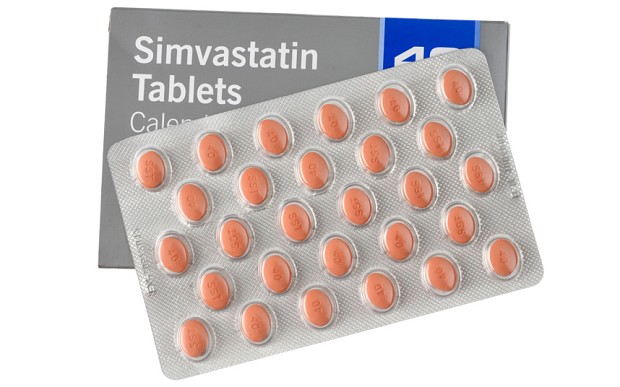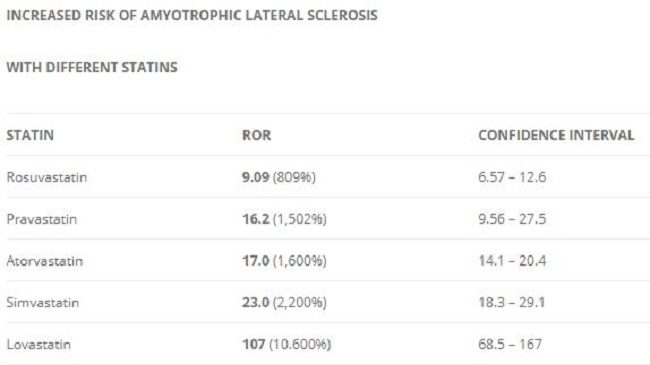Over a decade ago, in 2007, I was sent a link to a World Health Organisation study which reported the following:
'The WHO Foundation Collaborating Centre for International Drug Monitoring (Uppsala Monitoring Centre [UMC]) has received many individual case safety reports (ICSRs) associating HMG-CoA reductase inhibitor drug (statin) use with the occurrence of muscle damage, including rhabdomyolysis, and also peripheral neuropathy. A new signal has now appeared of disproportionally high reporting of upper motor neurone lesions.' 1This reported has niggled at the back of my mind for a long time. There are few conditions that can match 'upper motor neurone disease/amyotrophic later sclerosis' for sheer bloody awfulness. Here I quote from Wikipedia:
'Amyotrophic lateral sclerosis (ALS), also known as motor neurone disease (MND), and Lou Gehrig's disease, is a specific disease which causes the death of neurons controlling voluntary muscles. Some also use the term motor neurone disease for a group of conditions of which ALS is the most common. ALS is characterized by stiff muscles, muscle twitching, and gradually worsening weakness due to muscles decreasing in size. This results in difficulty speaking, swallowing, and eventually breathing.With ALS, your brain remains unaffected, whilst your body dies around you. People suffering ALS are often the ones you see in front of the High Court asking for a change in the law, so that they can be assisted to die, rather than suffocating to death. Thus far, in the UK, the courts have remained impervious to basic, caring, humanity. [You may infer what my views are on this matter].
The cause is not known in 90% to 95% of cases. The remaining 5-10% of cases are inherited from a person's parents. About half of these genetic cases are due to one of two specific genes. The underlying mechanism involves damage to both upper and lower motor neurons. The diagnosis is based on a person's signs and symptoms, with testing done to rule out other potential causes.
No cure for ALS is known. A medication called riluzole may extend life by about two to three months. Non-invasive ventilation may result in both improved quality and length of life. The disease can affect people of any age, but usually starts around the age of 60 and in inherited cases around the age of 50. The average survival from onset to death is two to four years. About 10% survive longer than 10 years. Most die from respiratory failure. In much of the world, rates of ALS are unknown. In Europe and the United States the disease affects about two to three people per 100,000 per year.'
Now, I have known for many years that statins are likely to cause damage to nerve cells. Probably through a direct effect on inhibiting cholesterol synthesis. Synapses are made, primarily, of cholesterol. Cholesterol is required to maintain the health of the myelin sheath, that surrounds and protects neurones. Glial cells in the brain, sustain the myelin sheath by synthesizing their own cholesterol and transferring it across to neurones, and suchlike.
Knowing how vital cholesterol is for the health of neurones, I have always been concerned that statins could well lead to 'neurone damage' of one sort of another. Which is why the WHO report from 2007 rang serious alarm bells. Bells which have never chimed again. Until very recently.
A couple of weeks ago I was sent the following paper that was published in the Journal Drug Safety. 'Amyotrophic Lateral Sclerosis Associated with Statin Use A Disproportionality Analysis of the FDA's Adverse Event Reporting System.'2
Here are the main results. I have copied them unchanged, as there are those who read this blog who will understand what they mean without any explanation
'RORs [Relative Odds Ratios] for ALS were elevated for all statins, with elevations possibly stronger for lipophilic statins. RORs ranged from 9.09 (6.57-12.6) and 16.2 (9.56-27.5) for rosuvastatin and pravastatin (hydrophilic) to 17.0 (14.1-20.4), 23.0 (18.3-29.1), and 107 (68.5-167) for atorvastatin, simvastatin, and lovastatin (lipophilic), respectively. For simvastatin, an ROR of 57.1 (39.5-82.7) was separately present for motor neuron disease.'An odds ratio, basically means increased (or decreased) risk of something happening relative to the standard risk of one. An odds ratio of two (2) means something is twice as likely to happen. An odds ratio of nine (9) means something is nine times as likely to happen. This can also be represented as 900% increase in risk.
Stripping these figures out, we find the following increased risk of ALS associated with the use of different statins. Some statins are more likely to enter the brain than others (atorvastatin, simvastatin and lovastatin) because they are lipophilic (attracted to lipids), these ones had higher RORs. The two most widely prescribed statins are simvastatin and atorvastatin. Atorvastatin increases risk seventeen told, and simvastatin twenty three fold.
It is often said that association does not mean causation. However, this is only true up to a point. Most statisticians agree that an odds ratio > 6 represents proof of causation. When you find that people taking atorvastatin have a seventeen-fold increase in risk of ALS, this is proof of causation. The effect is too massive to be due to anything else.
So, what does all this mean in the real world. Well around two to three people per 100,000 develop ALS every year (call this 2.5/100,000). If you increase this seventeen-fold, then around forty more people will develop ALS every year, per 100,000.
Taking this up a scale. In the UK it is estimated that around seven million people are now taking statins. This figure would be around six times higher in the US, or around forty million, giving us forty-seven million statins users. Let us round this up to fifty million for the UK and US combined.
So, how many more people are likely to be developing ALS each year, as a result of taking statins? I have used a combined average OR of 20 (i.e., (17 + 23)/2 ), by combining simvastatin and atorvastatin in the calculation, as these are the most widely prescribed statins.
Let us first look at how many people out of 50,000,000 would develop ALS in the 'non-statin treated' population.
Number of people = 50,000,000
Number of people expected to develop ALS = 2.5/100,000
Number of people developing ALS/ 50,000,000 = 50,000,000/100,000 x 2.5 = 1,250
In short, in a population of fifty million people, not taking statins, we can calculate that around 1,250 would develop ALS every year.
On the other hand, in a population of fifty million people taking statins (atorvastatin and simvastatin) we can expect that figure to be multiplied by around twenty. Now instead of 1,250 people developing ALS, we can expect to see 20 x 1,250 = 25,000.
Or, to put this another way. Each year, in the US and the UK, we can expect to see an extra 23,750 people developing Amyotrophic Lateral Sclerosis due to taking statins.
Now, you may think this is one hell of a lot of people, surely someone would notice. In truth, an increase like this is unlikely to be spotted by anyone. Looking at the UK, each year you might expect to see an extra 3425 cases of ALS each year.
There are around fifty thousand General Practitioners in the UK. So, each GP might expect to see an extra statin related ALS case every sixteen years or so. Or a maximum of two in their working life. You would have to be exceptionally alert to associate one extra case of ALS every sixteen years to statin use. The reality is that this would never, ever, happen.
How else can you spot a rise? Well, you might find this difficult to believe, but the number of people with ALS is not that accurately reported. Even when someone dies, and has ALS, this may not be recorded as the primary cause of death. They may be recorded as dying of a respiratory infection, with ALS as the secondary cause.
To quote from the US ALS association: 'First, ALS is not a notifiable disease, and ensuring that all newly diagnosed and prevalent ALS cases in the United States are collected in the Registry is challenging.' In short, we do not really know how many people have ALS, how many are coded as having something else, and suchlike.
I have looked around for evidence of a rise, and it does seem to exist. In Finland, after the introduction of statins the rate of ALS tripled 3. It also went up sharply in the UK but has levelled off since the mid-nineties. In Norway, it doubled in the nineteen nineties4. It is increasing in the US, but the authorities have written this off as due to better detection and notification.
In Australia ALS has risen. 'In 2015, 758 people with MND died compared with 592 people with MND who died in 2001. The cause of this increase is mostly unknown.' 5
So, there are strong signals that ALS has sharply increased in several countries. Cause and effect? Well, if the study in Drug Safety is correct, there must have been a rise in ALS caused by statins.
Frankly, I don't expect my fifty million number is that accurate. It is clear that many people simply stop their statin after a year, or so. So, although fifty million may be the estimate of how many people are taking statins in the US and UK, it is probably more like ten to twenty million, who regularly take their statins. So, my figure of 23,750 is probably more like 10,000.
However, you must ask yourself this question. If statins are causing ALS in 10,000 people each year in the UK and the US, alone, should we not be demanding an immediate review? Because the number one requirement of medicine is Priumum non Noncere. First, do no harm.
References:
1: https://www.ncbi.nlm.nih.gov/pubmed/17536877
2: https://doi.org/10.1007/s40264-017-0620-4
3: https://www.ncbi.nlm.nih.gov/pubmed/11589652
4: https://www.ncbi.nlm.nih.gov/pubmed/11087765
5: https://www.mndaust.asn.au/Get-informed/What-is-MND/Facts-and-figures.aspx





Reader Comments
to our Newsletter